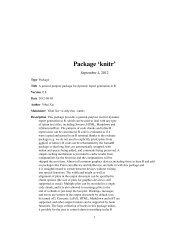Package 'openair'
Package 'openair'
Package 'openair'
You also want an ePaper? Increase the reach of your titles
YUMPU automatically turns print PDFs into web optimized ePapers that Google loves.
88 polarFreq## how many points are there in each cluster?table(results$data$cluster)## plot clusters 3 and 4 as a timeVariation plot using SAME colours as in## cluster plottimeVariation(subset(results$data, cluster %in% c("3", "4")), pollutant = "nox",group = "cluster", col = openColours("Paired", 6)[c(3, 4)])## End(Not run)polarFreqFunction to plot wind speed/direction frequencies and other statisticsDescriptionUsagepolarFreq primarily plots wind speed-direction frequencies in ‘bins’. Each bin is colour-codeddepending on the frequency of measurements. Bins can also be used to show the concentration ofpollutants using a range of commonly used statistics.ArgumentspolarFreq(mydata, pollutant = "",statistic = "frequency", ws.int = 1, grid.line = 5,breaks = seq(0, 5000, 500), cols = "default",trans = TRUE, type = "default", min.bin = 1,ws.upper = NA, offset = 10, border.col = "transparent",key.header = statistic, key.footer = pollutant,key.position = "right", key = TRUE, auto.text = TRUE,...)mydatapollutantstatisticA data frame minimally containing ws, wd and date.Mandatory. A pollutant name corresponding to a variable in a data frame shouldbe supplied e.g. pollutant = "nox"The statistic that should be applied to each wind speed/direction bin. Can be“frequency”, “mean”, “median”, “max” (maximum), “stdev” (standard deviation)or “weighted.mean”. The option “frequency” (the default) is the simplestand plots the frequency of wind speed/direction in different bins. The scaletherefore shows the counts in each bin. The option “mean” will plot the meanconcentration of a pollutant (see next point) in wind speed/direction bins, and soon. Finally, “weighted.mean” will plot the concentration of a pollutant weightedby wind speed/direction. Each segment therefore provides the percentage overallcontribution to the total concentration. More information is given in theexamples. Note that for options other than “frequency”, it is necessary to alsoprovide the name of a pollutant. See function cutData for further details.
















